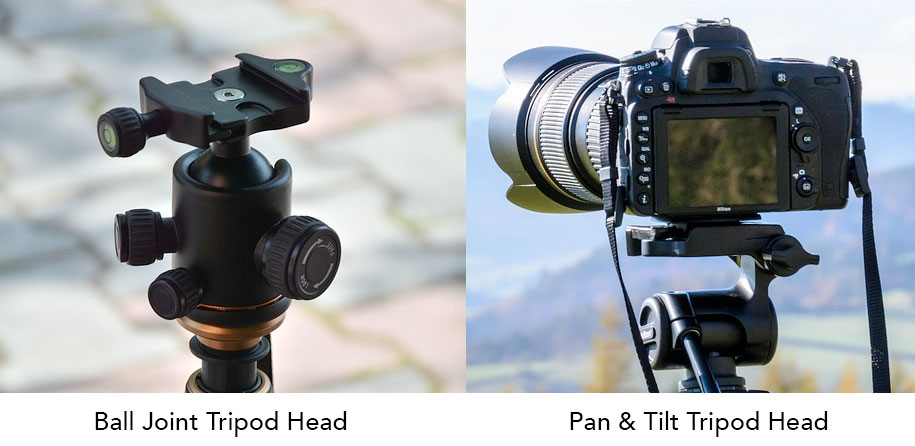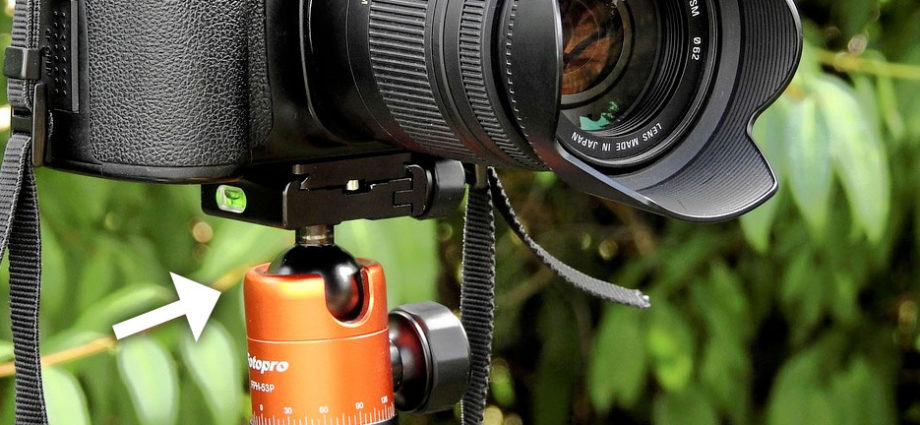If you’re reading this article, you’re probably interested in ball head tripods, the advantages they can provide you with, and what the best tripod with a ball head joint is.
If you want to skip down the page straight to our recommended ball joint tripods, click here ↓.
But first, let’s define our terms.
What is a ball joint tripod or ball head tripod?

A tripod with ball head is a specific type of video tripod or tripod for still photography that uses a ball joint instead of a traditional pan and tilt head. With a high quality ball tripod mount you can still pan and tilt as you would with a normal tripod, but you also have the ability to adjust your camera to a virtually unlimited number of odd angles in addition.
Advantages of ball joint tripod heads for still photographers & video shooters
Different people prefer different types of tripod styles. What’s great for one person might not be perfect for everyone or every individual shooting situation. With that said, here are some advantages that using a tripod with ball head might provide you with, regardless of whether you’re a still photographer or a filmmaker:
- Ball tripods can be very quick and easy to set up because you can “level” them (often with a built in bubble level) rapidly, making them ideal for fast-paced run and gun shooting
- Tripods with ball joints are easy to deploy on uneven surfaces such as hills or outdoors because they can adjust to virtually any custom angle, which may not be as easy with pan and tilt tripods
- Using a ball head tripod may make it easier to “follow” a subject that is moving around (e.g. at sports events or as a person paces around a room)
With that said, let’s take a look at some options for the best ball head tripods.
The best tripods with ball heads
K&F Lightweight Aluminum DSLR Tripod
If you’re looking for the best ball head tripod under $100, this model could be a good fit. It’s one of the best budget ball head tripods with a quick release plate for easy deployment and it weighs a mere 2.5 pounds. Fully extended it reaches up to 62 inches (just over 5 feet or 1.5 meters), and collapsed it measures only 18 inches. Because it uses a ball head tripod head, it can achieve all sorts of odd angles that you might not easily reach with a regular old pan and tilt head tripod. The ball joint head on this tripod also has a bubble level which lets you judge whether or not it’s straight, even on un-even surfaces. Its maximum load capacity is an astonishing 22 pounds (10 kilograms), so it’s heavy duty despite being lightweight itself. This also makes it a solid travel tripod.
Manfrotto Element Traveler Lightweight Tripod
If you’re looking for a very high quality ball head tripod for DSLRs or other light cameras, this tripod might fit the bill perfectly. It weighs a mere 3.5 pounds (!) and can handle a maximum load of more than 17 pounds. Its folded length is just 16 inches but it expands to a height of 57 inches, or over four feet. This is a great travel tripod with a ball head and it’s size is ideal for still photographers who need a sturdy professional grade set of sticks. Like other pro level tripods, this one features a quick release lock system that allows you to mount and unmount your camera on and off the tripod with just a swift click of a single latch, instead of endless twisting around a mount screw. The Manfrotto Element Traveler tripod is one of the best ball head tripods under $200. (Its lack of a handle grip for panning will make it not ideal for video shooting however. Keep scrolling down if you need a ball head tripod with a pan handle for shooting video.)
Manfrotto MVH502A + 546BK-1 Professional Fluid Video System with Aluminum Legs and Mid Spreader (Black)
This professional level Manfrotto ball-head tripod is extremely solid and able to support cameras that weigh up to 15 pounds. Featuring reinforced legs, this tripod also has a detachable mid-height spreader which helps you rapidly deploy or fold up the tripod without having to fumble with individual legs. The MVH502A head and the 546BK-1 legs combine to make a fluid tripod system provides silky smooth motion when you’re panning, tilting, or following a subject as they move. It also has a generous pan handle with a padded grip and sturdy feet.
Like other high quality ball head tripod for video this model has adjustable drag on nearly all of its moving parts so you can control how quick or smooth your pans and tilts are (on a scale from whip fast when they’re set to loose to molasses slow when the tension knobs and dials are set to tight). The legs are two stage and fold into a surprisingly compact length of about 33 inches. The maximum height of this ball joint tripod is 66 inches, or about 5’6″.
Sachtler 1001 Ace Fluid Head Tripod
The Sachtler 1001 camera tripod with ball head is a very sturdy pro level tripod with pan bar. It features a mid-height spreader which makes these sticks quick to deploy and fold up without stooping too far down. It weighs an astonishingly light 3.7 pounds, it can accommodate up to about 8 pounds, so small DSLRs and similar cameras are perfectly sized. With adjustable levels of drag you can pan and tilt and do other camera movements in either a silky slow smooth motion or a fast whip-like jerk and anywhere in between.
Sachtler Ace XL Tripod System
If you need a heavy duty tripod with a ball joint head to support a heavy camera, consider this pro level Sachtler model. It can support almost 20 pounds (the tripod itself weighs about 9 pounds so it’s quite sturdy). It folds into 34 inches when it’s collapsed into its included tripod carrying case and can expand up to 68 inches tall (5’8″ or 172 centimeters). The fluid head on this ball joint tripod allows for smooth precise camera motions and the generously sized pan handle makes camera movement easy to control. The Sachtler Ace XL also comes fitted with a detachable ground spreader which you can use to quickly deploy or retract making it a great ENG tripod for news reporters in fast paced run and gun style shooting situations.
Frequently asked questions about ball head tripods
Can you adjust the level of drag on a tripod with ball head?
Yes! At least you can on professional level ball head tripods. Cheaper models of ball tripods may not have pro features like adjustable pan or tilt drag or tightness/looseness on the ball joint itself, but high end tripods like the Manfrotto or Sachtler models listed above do allow for extensive customization of drag levels which let you choose how rapidly or slowly you want to make camera movements.
What is the difference between a tripod for still photography vs a video tripod?
There are a few differences between tripods meant for video vs tripods meant for still photography. The most obvious may be the weight class of camera that the tripod is designed to support. Video cameras traditionally have been heavier and larger than still cameras so video tripods usually can accommodate heavier payloads, whereas photo tripods haven’t needed to be quite as sturdy (although some pro still DSLRs can get pretty heavy when you attach long telephoto lenses like you see at pro sporting events).
Similarly, photo tripods tend to be thinner and more slender whereas video tripods are often more chunky, heavier and bigger.
Another difference between still camera tripods and tripods for filming or video is that video tripods are designed to allow smooth camera motions. Movements like pans from side to side or tilts up and down can be jerky on a cheaper still photography tripod because the manufacturers of those tripods assume their users are going to be taking photos so it doesn’t matter. But tripods that are intended for video use fluid heads that make motion smooth. Higher end fluid head tripods have adjustable levels of drag or resistance that can make pans or tilts faster or slower but still smooth.
What is the best lightweight ball head tripod?
For still photo use, we love the Manfrotto Element tripod. If you’re shooting video within a budget, we’d go with the Manfrotto MVH502A. If budget is no object and you’re shooting video, we might consider the Sachtler Ace XL for its sturdy build quality and good warranty.





